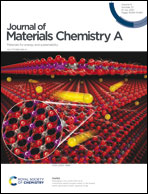A superhydrophobic and anti-corrosion strain sensor for robust underwater applications†
Abstract
Exploration of wearable strain sensors in diverse application scenarios is one global requirement for shaping the future of our intelligent community. However, state-of-the-art wearable devices still face challenges such as interference under humid conditions and chemical/mechanical fragility. Here, a facile and fluorine-free approach is introduced to realize a sensitive, robust and superhydrophobic strain sensor via the in situ formation of microcilia on the PDMS surface, followed by a two-step swelling process. The swelling process facilitates the penetration of carbon black nanoparticles into the PDMS matrix to render the conductive network suitable for strain sensing, while the decoration of silica nanoparticles along with the microcilia forms a hierarchical architecture for water repellency. The sensing performance was optimized, including the sensitivity (gauge factor of 354), working range (up to 250%), and long-term stability (>10 000 cycles). The superhydrophobic surface exhibits excellent resistance to mechanical abrasion, chemical corrosion, and high-speed water impact, etc. Demonstrations, such as body motion perception, wireless and underwater communications, Morse code generation, underwater jet impact, reveal the potential of the sensor as a robust platform for broad applications not only in air but also for underwater or under harsh condition uses.



 Please wait while we load your content...
Please wait while we load your content...